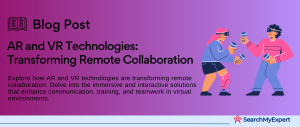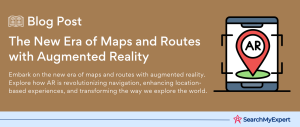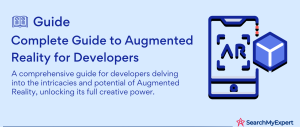Accessibility in AR & VR
Augmented Reality (AR) and Virtual Reality (VR): A New Digital Frontier
In the swirl of technological evolution, two stars shine brightly: Augmented Reality (AR) and Virtual Reality (VR). AR blends digital components with the real world, enhancing our perception through devices like AR glasses. Imagine walking through a city, and your glasses display historical facts about landmarks or translate street signs in real-time. VR, on the other hand, transports us into entirely digital realms. With VR headsets, we can explore virtual worlds, from the depths of oceans to the far reaches of space, all from our living rooms.
AR/VR: Revolutionizing Fields Far and Wide
The potential of AR and VR stretches across various sectors:
- Education:
Transforming classrooms into interactive learning environments. Imagine history lessons where students can virtually visit ancient civilizations. - Healthcare:
Enabling doctors to visualize complex medical data or practice surgeries in a risk-free virtual setting. - Gaming: Creating immersive gaming experiences that blur the lines between reality and fantasy.
- And More:
From retail to real estate, AR and VR are reshaping how we interact with products and spaces.
The Heart of the Matter: Accessibility in Technology
At the core of AR and VR’s evolution is accessibility – ensuring these technologies are usable and beneficial for everyone, regardless of physical or cognitive abilities. In a world increasingly reliant on digital interactions, accessibility in AR and VR isn’t just a nice-to-have; it’s a must. It’s about creating inclusive experiences that empower all users, breaking down barriers and opening up new possibilities.
As we dive into the world of AR and VR, we’re not just exploring new technologies. We’re pioneering new ways to connect, learn, heal, and play. The journey into AR and VR is more than a technological leap; it’s a step towards a more inclusive and accessible digital future.
Understanding Disabilities in the Context of AR/VR
Diverse Abilities, Diverse Challenges
In the realm of AR and VR, accessibility must be a priority, catering to a spectrum of disabilities. Each type of impairment presents unique challenges in the digital landscape.
Visual Impairments
- Impact:
Difficulty in perceiving visual cues, which are fundamental to AR/VR experiences. - AR/VR Experience: Rely on audio descriptions, haptic feedback, and enhanced contrast settings.
Hearing Impairments
- Impact:
Challenges in receiving auditory information, crucial in immersive VR environments. - AR/VR Experience:
Utilize visual alerts, subtitles, and sign language integration.
Motor Impairments
- Impact: Limited mobility or fine motor control can hinder interaction with standard controllers.
- AR/VR Experience:
Adaptive controllers, voice commands, and head tracking enhance accessibility.
Cognitive Impairments
- Impact:
Difficulty in processing complex interfaces or navigating fast-paced environments. - AR/VR Experience: Simplified interfaces, customizable pace, and clear, concise instructions are key.
Each impairment requires thoughtful design considerations to ensure AR and VR technologies are not just groundbreaking, but also ground-leveling, providing equal access to all. By understanding and addressing these challenges, AR/VR can evolve into tools that empower, rather than exclude, enhancing experiences for every user, regardless of their abilities.
Challenges of Accessibility in AR/VR
Navigating the Obstacle Course of Inclusivity
Creating accessible AR/VR experiences is akin to solving a complex puzzle, with several pieces needing careful attention:
Awareness Among Developers and Designers
- Issue:
Many creators lack awareness or understanding of accessibility needs. - Impact: This leads to designs that unintentionally exclude certain users.
Limited Accessible Hardware and Software
- Issue:
The market has a scarcity of hardware and software tailored for diverse abilities. - Impact:
This limits the usability of AR/VR for people with specific impairments.
Design Limitations
- Issue:
Some designs inherently exclude users with certain disabilities. - Impact:
This creates a barrier for those who cannot interact with standard interfaces.
3D Navigation Challenges for Motor Impairments
- Issue:
Navigating in three-dimensional spaces can be daunting for those with motor impairments. - Impact:
It results in a frustrating and inaccessible experience.
Audio Descriptions and Alternative Inputs for the Visually Impaired
- Issue:
Providing comprehensive audio descriptions and alternative inputs remains a challenge. - Impact:
Visually impaired users may find it difficult to fully engage with AR/VR content.
To overcome these challenges, a collaborative effort is needed – one that combines the expertise of technologists, designers, and most importantly, the insights of those with disabilities. It’s about building a bridge where technology meets empathy, ensuring AR and VR are accessible gateways to incredible experiences for all.
Best Practices for Accessible AR/VR Development
Creating accessible AR/VR experiences is a journey of continuous learning and adaptation. Here are some key guidelines for developers and designers:
Involve Users with Disabilities in the Design Process
- Why? Gain real insights into the challenges and needs.
- Result:
More empathetic and effective design solutions.
Follow W3C Accessibility Guidelines
- Why? Ensures a universally accepted standard of accessibility.
- Result:
Creates a consistent and inclusive user experience.
Implement Alternative Input Methods
- Methods: Voice control, eye tracking, gesture recognition.
- Result:
Broader usability, catering to various motor and cognitive abilities.
Provide Audio Descriptions and Transcripts
- Why? Makes visual content accessible to visually impaired users.
- Result:
Enhances understanding and engagement for all users.
Design User-Friendly Interfaces
- Focus:
Easy navigation for users with motor impairments. - Result:
Smoother, frustration-free interaction.
Ensure Adequate Contrast and Color Choices
- Why? Assists users with color blindness or low vision.
- Result:
Visual content becomes more perceivable and distinguishable.
By adhering to these practices, developers can create AR/VR experiences that are not just technologically advanced, but also socially inclusive. It’s about harnessing the power of technology to build a world where everyone has a chance to explore, learn, and enjoy without barriers.
Examples of Accessible AR/VR Applications
In the realm of AR and VR, some trailblazers have set exemplary standards in accessibility:
VR for Visually Impaired: Haptic Feedback Exploration
- What? VR experiences tailored for visually impaired users.
- How? Utilizes haptic feedback to convey spatial information and object textures.
- Impact: Enables visually impaired users to ‘feel’ and navigate virtual environments.
AR with Audio Cues for Motor Impairments
- What? AR applications are designed for users with motor impairments.
- How? Employs audio cues to guide users through tasks in the real world.
- Impact: Assists users with motor impairments in performing everyday activities more independently.
Educational VR with Transcripts for Deaf and Hard-of-Hearing Users
- What? VR educational tools with enhanced accessibility features.
- How? Provides transcripts and audio descriptions, catering to deaf and hard-of-hearing users.
- Impact: Makes educational content in VR environments more accessible and inclusive.
These applications are not just technological innovations; they are beacons of inclusivity, demonstrating how AR and VR can be harnessed to create experiences that are accessible to a wider range of users. They exemplify how technology, when thoughtfully designed, can bridge gaps and create opportunities for all.
The Future of Accessible AR/VR
Charting the Course to an Inclusive Digital Realm
The future of AR and VR is not just about technological advancements; it’s about crafting a more inclusive world. Here’s a glimpse into what lies ahead:
AI-Powered Accessibility Tools
- What? Intelligent systems that adapt to individual user needs.
- Potential:
These tools can offer real-time language translation, context-aware assistance, and personalized user interfaces. - Impact: Makes AR/VR experiences more intuitive and accessible for a diverse user base, including those with cognitive and sensory impairments.
Brain-Computer Interfaces (BCIs)
- What? Technology enabling direct control of AR/VR experiences through brain signals.
- Potential:
BCIs could allow users with severe motor impairments to navigate and interact in digital environments using their thoughts. - Impact: Opens up AR/VR to individuals who are currently unable to use traditional input methods.
Standardization of Accessibility Features
- What? Establishing universal standards for accessibility in AR/VR platforms.
- Potential:
Ensures that accessibility is not an afterthought but a fundamental aspect of design. - Impact: Creates a consistent and universally accessible AR/VR landscape, fostering innovation while ensuring inclusivity.
As we peer into the horizon of AR and VR, these advancements are not just mere possibilities; they are the building blocks of a future where technology empowers everyone, irrespective of their abilities. The journey towards accessible AR/VR is one of hope, innovation, and relentless pursuit of inclusivity.
Embracing Inclusivity in AR/VR
A Call to Build a World Without Digital Borders
As we reach the end of our exploration into accessibility in AR and VR, one thing is crystal clear: Accessibility isn’t just a feature; it’s a cornerstone of innovation. It’s about creating a digital environment where everyone, regardless of their abilities, can participate, explore, and thrive.
A Collective Responsibility
- Developers and Designers:
You are the architects of this new digital frontier. Design with empathy, innovate with inclusivity in mind. - Policymakers:
Set the stage for a more inclusive future by establishing standards and encouraging practices that prioritize accessibility. - Community:
Your voice matters. Advocate for inclusive technologies, support developments that break down barriers.
The Future is Inclusive
The path to creating accessible AR/VR experiences is paved with challenges, but it’s a journey worth taking. It’s about building a world where technology brings us together, making experiences richer and more meaningful for all. Let’s commit to this vision, where AR and VR aren’t just about new realities, but about better, more inclusive ones.
Conclusion
Accessibility in AR and VR is essential for creating inclusive experiences. It’s a call to action for developers, designers, and policymakers to innovate with empathy, ensuring that these transformative technologies open new worlds for all users, regardless of their abilities. The future of AR and VR lies in our collective effort to make it accessible, equitable, and empowering for everyone.
Innovate beyond boundaries with AR & VR Development Service Firms.
Table of Contents
Toggle






